1. Persons who voted in Municipal elections 2017
This review examines persons entitled to vote and those who voted in the Municipal elections 2017 according to various background factors. The data on persons entitled to vote and those who voted derive from the voting register of the Election Information System of the Ministry of Justice. The unit-level background data are based on Statistics Finland’s data, such as population, employment and family statistics, and the Register of Completed Education and Degrees. The examined groups are, on one hand, all persons entitled to vote in the Municipal elections 2017 and advance voters, and, on the other, persons entitled to vote in voting districts that used the electronic voting register in the Municipal elections 2017, and advance voters and those who voted on the election day in these districts.
The electronic voting register enables examination of voting turnout also in terms of votes cast on the election day. Thus, voting data including both advance voters and those who voted on the election day are available from areas using the electronic voting register. Data that contain all who voted provides a complete picture of voting turnout as they can reliably help take into account those who did not vote. This is not possible for advance voters. In this review, advance voters refer to all persons that voted in advance throughout the country and all who voted refer to both advance voters and those who voted on the election day in the above-mentioned areas.
It should be noted that the data presented in the review concerning all who voted do not cover the entire country or all persons entitled to vote. In this review, all who voted refer to the actual event of voting, that is, all who voted include the available data on persons who voted on the election day and in advance in defined areas. The data presented in this review have not been edited in any way, for example, by weighting the data based on background factors, the breakdowns are presented as they are in the data. In other words, the data presented on all who voted in a particular area only apply to the municipalities, voting districts and persons entitled to vote for which data are available.
Analysed data
When examining the analyses presented in this review it should be noted that the analyses examine two separate but partially overlapping voter groups. The following terms are used for these voter groups in the text, tables and figures of the review:
-
Advance voters that cover all persons that voted in advance in the elections, and
-
All who voted in the areas that cover advance voters and persons entitled to vote on the election day in the voting districts that used the electronic voting register.
The voter groups used in the review are not mutually exclusive. The advance voters of the entire country also include the persons entitled to vote who voted in advance in the above-mentioned areas. All who voted in the areas, in turn, also include all persons that voted in advance in those particular areas. Thus the group “advance voters” depicts, just like the name suggests, persons entitled to vote who voted in advance in the entire country, and the group “all who voted in the areas” covers persons who voted on the election day and in advance in a limited number of voting districts.
There were 4,391,558 persons entitled to vote in the Municipal elections 2017. Of these persons entitled to vote, 1,169,319, or 26.6 per cent of all persons entitled to vote, voted in advance. The voting districts where data on voting on the actual election day are available had 1,377,448 persons entitled to vote. So complete voting data are available for 31.4 per cent of persons entitled to vote.
Unit-level background factors could not be linked to all persons entitled to vote so such cases were excluded from the data. Thus, the data that were used for the whole country had 4,391,074 and the examined areas had 1,377,311 persons entitled to vote. It should be noted that in terms of background variables used in individual analysis these numbers may be smaller than the figures mentioned above depending on how extensively the background variables could be linked to the persons entitled to vote. In practice, this is visible, for example, in that the distributions presented in the figures and tables may vary slightly by background variable.
Data coverage
The voting districts and municipalities for which all voting data were received are not divided entirely equally on the level of the whole country. Data on voting on the actual election day were available from 116 municipalities, from 59 municipalities for all voting districts and for 57 municipalities from some voting districts.
Voting data from the election day were available from all constituencies. However, the coverage of the data varies by constituency. The most comprehensive data were available from the constituency of Central Finland, 75.0 per cent of persons entitled to vote in the constituency. Data were also more comprehensive than for the entire country in the constituencies of Lapland (63.2% of persons entitled to vote), Uusimaa (45.1%), Satakunta (38.9%), Pirkanmaa (32.7%), Varsinais-Suomi (32.5%) and Vaasa (31.6%). The coverage for election day voting data was lowest in the Helsinki constituency where data were available only for two voting districts and for 0.9 per cent of persons entitled to vote. In other words, the Helsinki constituency is clearly under-represented in the available data. (See Appendix table 1)
Appendix table 2 examines the background factors of persons entitled to vote in the entire country and in areas with complete voting data. In the Municipal elections 2017, the average age of persons entitled to vote was 50.2. In this respect, the persons entitled to vote in certain areas do not differ from all persons entitled to vote. Of all persons entitled to vote, men represented 48.8 per cent in the whole country, as much as in the areas in relative terms.
The median income of persons entitled to vote in the whole country was slightly higher than for persons entitled to vote in the areas. The difference is EUR 231 per year. The biggest difference between the backgrounds of all persons entitled to vote and those who lived in the areas of the electronic voting register during the Municipal elections 2017 is found in the level of education. In the whole country, persons entitled to vote were, on average, more highly educated than in the examined areas with the electronic voting register. The difference is, in particular, visible in the highest examined group of education, those with higher tertiary level or doctorate level education, of whom there were 1.4 percentage points more in the entire country than in the areas.
There are small differences between all persons entitled to vote and persons entitled to vote living in the areas when it comes to main type of activity categories. There were slightly more employed persons (0.5 percentage points) in the whole country than in the areas, and, correspondingly, the areas had more students (0.3 percentage points) and pensioners (0.4 percentage points). The areas had somewhat more (0.9 percentage points) Finnish-speaking persons than the entire country. The share of persons with Finnish background was 0.4 percentage points higher than in the whole country.
In all areas from which voting data for the actual election day were available, support for the Centre Party was on level with the result for the whole country. Support for the Coalition Party was slightly lower than for the whole country in the areas with the electronic voting register, 1.3 percentage points difference. By contrast, support for the Finns Party was slightly higher in the areas than in the whole country. The difference between the areas and the support for the parties in the election was biggest for the Social Democratic Party, the party’s support in the areas was 2.1 percentage points higher than the result for the whole country.
The factors presented in this Section and in Appendix tables 1 and 2 should be considered if the data obtained on all who voted in the areas with an electronic voting register are to be generalised to relate to all persons entitled to vote.
Age and sex
Altogether, 1,169,319 persons entitled to vote voted in advance in the Municipal election 2017, which is 26.6 per cent of all persons entitled to vote. The advance voting percentage reported by Statistics Finland is 45.2. The advance voting percentage is derived by calculating the share of advance voters among those having voted. In this review, persons who voted are examined in relation to persons entitled to vote, so the percentages given are lower than the advance voting percentage.
In voting areas where all voting data were available, a total of 793,999 persons entitled to vote cast their vote, which was 57.6 per cent of the persons entitled to vote in the areas. In these areas, 27.0 per cent of persons entitled to vote voted in advance and 30.6 per cent persons entitled to vote voted on the election day.
Age clearly has an impact on voting. The share of advance voters among persons entitled to vote exceeds 20 per cent at the age of 49, after which the share grows faster than earlier. Advance voting was most common among persons aged 73, of whom 49.8 per cent voted in advance. The share of advance voters starts to drop after the age of 73 and among persons aged 96 the share of advance voters was 20.9 per cent of persons entitled to vote. (Figure 1.)
Figure 1. Share of those who voted among persons entitled to vote by age in the Municipal elections 2017, %
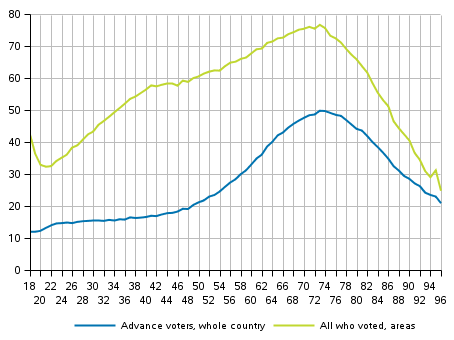
The share of all persons that voted in the areas among persons entitled to vote provides a more detailed picture of the occurrence than only advance voting. The voting percentage of persons who reached the voting age of 18 in 2017 was 42.5 per cent in the areas after which it drops to 33.0 per cent among 20-year-olds. After this, the voting percentage grows quite evenly to 57.6 per cent among persons aged 42. After the 42 age group, the voting percentage grows by age but more slowly than before and is at its highest for the group of 73-year-olds (76.7%). For persons aged over 73, the voting percentage drops relatively quickly but only drops below the level for 20-year-olds by the age of 93. (Figure 1.)
Women voted more actively than men in the Municipal elections 2017 both in advance and in the areas apart from the oldest examined age group. In the whole country, 28.7 per cent of women voted in advance, which was 4.2 percentage points higher than for men. In the examined areas, the voting percentage that takes into account all persons that voted is also higher for women. In the areas, 59.3 per cent of women voted, which was 3.6 percentage points higher than for men. Examined by age group, women voted more actively than men in all age groups except for persons aged 75 or over. (Table 1)
Table 1. Share of advance voters and all who voted among persons entitled to vote by sex and age in the Municipal elections 2017, %
| Age group | Total | Men | Women | |||
| Advance voters, whole country | All who voted, areas | Advance voters, whole country | All who voted, areas | Advance voters, whole country | All who voted, areas | |
| Total | 26.6 | 57.6 | 24.5 | 55.7 | 28.7 | 59.3 |
| 18-24 | 13.3 | 35.0 | 11.1 | 31.6 | 15.6 | 38.5 |
| 25-34 | 15.3 | 42.9 | 13.7 | 39.7 | 17.0 | 46.5 |
| 35-44 | 16.6 | 55.3 | 15.1 | 52.1 | 18.2 | 58.6 |
| 45-54 | 21.0 | 60.4 | 19.3 | 58.3 | 22.8 | 62.5 |
| 55-64 | 32.6 | 67.5 | 30.2 | 66.2 | 34.9 | 68.7 |
| 65-74 | 46.2 | 74.6 | 44.3 | 74.2 | 48.0 | 74.9 |
| 75- | 41.1 | 60.3 | 44.0 | 66.5 | 39.3 | 56.5 |
Main type of activity, education and family status
Measured by main type of activity, there were most pensioners among advance voters in relative terms in the Municipal elections 2017, in total 46.7 per cent of all advance voters. Pensioners are clearly over-represented among advance voters. The share of all other groups of main type of activity among advance voters was relatively smaller than among all persons entitled to vote. (Figure 2.)
When examining all who voted in the areas one can see that in two groups, the employed and pensioners, the share of voters in the group was higher than the corresponding share of all persons entitled to vote. By contrast, the share of those who voted belonging to the unemployed, students or other main type of activity in the areas was below the relative size of the group among all persons entitled to vote. (Figure 3.)
Figure 2. Persons entitled to vote and advance voters by main type of activity in the Municipal elections 2017, %
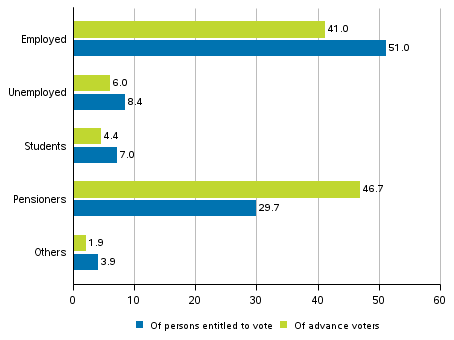
Figure 3. Persons entitled to vote and all who voted in the areas by main type of activity in the Municipal elections 2017, %
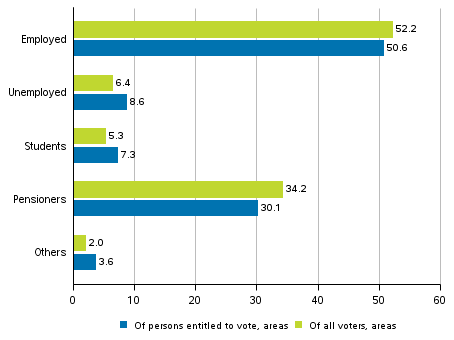
High education increases the probability of voting. Persons entitled to vote with upper secondary or higher educational level voted in advance in Municipal elections more than average. This is also visible for all who voted in the areas, persons with higher tertiary level or doctorate level education voted 23.4 percentage points more actively in the areas than all persons entitled to vote.
Previously (Figure 1) it has been noted that age has a clear connection with voting turnout. This is also visible in educational groups in which, in practice, all voting turnout increases with age, apart from the oldest age group, those aged 75 or over. This is visible both among advance voters and all who voted in the areas. (Table 3)
Table 2. Share of advance voters and all who voted among persons entitled to vote by age and level of education in the Municipal elections 2017, %
| Total | Lower secondary |
Upper secondary |
Lowest tertiary |
Lower tertiary |
Higher tertiary, doctorate |
||
| Total | Advance voters, whole country |
26.6 | 24.5 | 23.8 | 37.1 | 27.6 | 32.7 |
| All who voted, areas |
57.5 | 45.6 | 53.2 | 75.2 | 69.6 | 80.9 | |
| 18 to 24 | Advance voters, whole country |
13.3 | 10.4 | 15.3 | .. | 27.8 | .. |
| All who voted, areas |
35.0 | 32.1 | 36.7 | .. | 58.2 | .. | |
| 25 to 34 | Advance voters, whole country |
15.3 | 7.7 | 12.8 | 11.5 | 21.3 | 27.0 |
| All who voted, areas |
42.9 | 19.6 | 38.4 | 25.1 | 60.6 | 72.1 | |
| 35 to 44 | Advance voters, whole country |
16.6 | 9.8 | 14.4 | 18.7 | 19.3 | 23.2 |
| All who voted, areas |
55.3 | 27.5 | 48.7 | 64.5 | 67.1 | 77.7 | |
| 45 to 54 | Advance voters, whole country |
21.0 | 13.3 | 19.8 | 24.2 | 23.2 | 26.9 |
| All who voted, areas |
60.4 | 36.2 | 55.1 | 69.9 | 72.1 | 81.8 | |
| 55 to 64 | Advance voters, whole country |
32.6 | 25.2 | 31.6 | 37.7 | 37.7 | 38.8 |
| All who voted, areas |
67.5 | 51.4 | 64.7 | 77.3 | 80.3 | 85.8 | |
| 65 to 74 | Advance voters, whole country |
46.2 | 39.9 | 45.8 | 54.2 | 55.2 | 56.5 |
| All who voted, areas |
74.6 | 66.0 | 74.5 | 84.2 | 87.8 | 89.8 | |
| 75 and older |
Advance voters, whole country |
41.1 | 35.7 | 44.5 | 53.5 | 56.5 | 58.9 |
| All who voted, areas |
60.3 | 53.5 | 65.6 | 75.9 | 78.9 | 84.0 | |
When interpreting Table 3 it should be noted that lowest tertiary level qualifications decrease in the population and no new qualifications are completed in Finland in this category, so the age structure of the educational group differs clearly from other groups. Lowest tertiary level education covers qualifications above upper secondary level that are not university of applied sciences degrees. Among all persons entitled to vote, those with lowest tertiary level education are, on average, aged 59, while, for example, the average age of people with upper secondary level education is 46.5 and that of persons with lower tertiary level education is 44.3.
Examined by family status, the most active advance voters were persons without a family (28.4%) and married or cohabiting couples (28.1%). In this analysis, single parents refer to parents of one-parent families. In this group, advance voting was lower than in the two groups mentioned above (20.4%). In the group children living at home, which refers to adult children living with their parents, 15.0 per cent voted in advance.
Examination of all who voted in the areas does not change the picture of the groups’ voting turnout by family status. Measured by family status, married or cohabiting couples were the most active voter group, 65.6 per cent of them voted in the Municipal elections 2017. The voting percentage of other groups was below the level of all persons entitled to vote in the areas, fewer than 50 per cent of those entitled to vote among single parents and adult children living at home voted in the elections. Age group specific examination of all who voted does not change the picture of the effect of family status on voting turnout significantly. As a rule, the voting percentage grows in all family status groups by age, apart from the oldest age group of people aged 75 and over. (Figure 4, Table 3)
Figure 4. Share of those who voted among persons entitled to vote by family status in the Municipal elections 2017, %
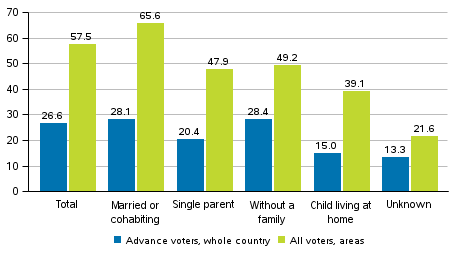
Table 3. Share of advance voters and all who voted among persons entitled to vote by family status in the Municipal elections 2017, %
| Total | Married or cohabiting |
Single parent |
Without a family |
Child living at home |
Unknown | ||
| Total | Advance voters, whole country |
26.6 | 28.1 | 20.4 | 28.4 | 15.0 | 13.3 |
| All voters, in areas |
57.5 | 65.6 | 47.9 | 49.2 | 39.1 | 21.6 | |
| 18 to 24 | Advance voters, whole country |
13.3 | 12.2 | 6.8 | 15.2 | 12.9 | 9.7 |
| All voters, in areas |
35.0 | 33.6 | 16.0 | 31.4 | 38.3 | 18.1 | |
| 25 to 34 | Advance voters, whole country |
15.3 | 14.8 | 10.7 | 16.9 | 16.2 | 10.1 |
| All voters, in areas |
42.9 | 48.7 | 28.1 | 37.3 | 36.6 | 19.1 | |
| 35 to 44 | Advance voters, whole country |
16.6 | 16.1 | 15.8 | 19.1 | 20.2 | 10.4 |
| All voters, in areas |
55.3 | 60.8 | 45.5 | 43.1 | 40.9 | 20.4 | |
| 45 to 54 | Advance voters, whole country |
21.0 | 20.5 | 20.6 | 23.0 | 25.9 | 12.8 |
| All voters, in areas |
60.4 | 66.2 | 54.3 | 47.3 | 47.8 | 23.3 | |
| 55 to 64 | Advance voters, whole country |
32.6 | 33.3 | 28.6 | 32.1 | 30.9 | 19.9 |
| All voters, in areas |
67.5 | 73.3 | 60.7 | 56.5 | 54.4 | 28.6 | |
| 65 to 74 | Advance voters, whole country |
46.2 | 48.2 | 37.3 | 43.3 | 36.9 | 25.1 |
| All voters, in areas |
74.6 | 79.7 | 63.4 | 65.5 | 59.1 | 32.5 | |
| 75 and older |
Advance voters, whole country |
41.1 | 47.1 | 28.9 | 37.6 | .. | 12.6 |
| All voters, in areas |
60.3 | 71.0 | 44.4 | 52.9 | .. | 14.6 | |
Income level
The income level of those who voted and persons entitled to vote is examined with the help of monetary income subject to state taxation. The income data for 2017 derive from the latest taxation data from 2015. Income subject to state taxation consists of earned income, entrepreneurial income, and other income subject to state taxation, including such as other earned income, pension income, unemployment benefits and other social security benefits. Income subject to taxation does not include such as grants and awards received from the general government, earned income received from abroad under certain conditions, some of social security benefits received from the public sector, and tax-free interest income.
In the data of the review, the income of persons entitled to vote is divided into deciles. Income deciles are derived by arranging persons entitled to vote by income and by dividing the group into ten equal parts. The groups formed in this way each have around 431,000 persons entitled to vote for all persons entitled to vote in the whole country. In areas from which data were received on voting on the election day as well, the groups have around 136,000 persons entitled to vote each.
For the whole country, income data are missing for 81,957 persons entitled to vote. In the data for areas containing election day votes, the income level was missing for 22,111 persons entitled to vote. The median income subject to state taxation of all persons entitled to vote was EUR 24,811, in the defined areas the corresponding median income was EUR 24,583. The income subject to state taxation of persons entitled to vote in the whole country belonging to the highest income decile was at least EUR 54,532 and in the examined areas it was EUR 52,945 per year. The income for those belonging to the lowest income decile was EUR 8,223 for the whole country and EUR 8,204 per year in the areas. (Table 4)
Table 4. Lowest limits for the income deciles of persons entitled to vote in the Municipal elections 2017, EUR
| Decile | All persons entitled to vote |
Persons entitled to vote in areas |
| 1st decile | 0 | 0 |
| 2nd decile | 8.223 | 8.204 |
| 3rd decile | 11.578 | 11.565 |
| 4th decile | 15.567 | 15.521 |
| 5th decile | 20.016 | 19.913 |
| 6th decile | 24.814 | 24.583 |
| 7th decile | 29.604 | 29.262 |
| 8th decile | 34.746 | 34.274 |
| 9th decile | 41.696 | 40.911 |
| 10th decile | 54.532 | 52.945 |
The effect of the income of persons who voted in advance is not that large as a whole. In the two lowest deciles, advance voting is relatively lower than in the higher income brackets. Starting from the third income decile, there are no major changes in the rate of advance voting, the share of advance voting in these categories varies from 26.5 to 31.7 per cent of persons entitled to vote. (Figure 5.)
When examining all who voted in the areas for which complete voting data were available, the effect of income on voting turnout is clearly more evident. In higher income groups, voting is, as a rule, more common than in lower income groups. Of persons belonging to the highest income decile, 75.7 per cent voted and in the lowest income decile voting turnout was only 38.8 per cent. (Figure 5.)
Figure 5. Share of those who voted among persons entitled to vote by income decile in the Municipal elections 2017, %
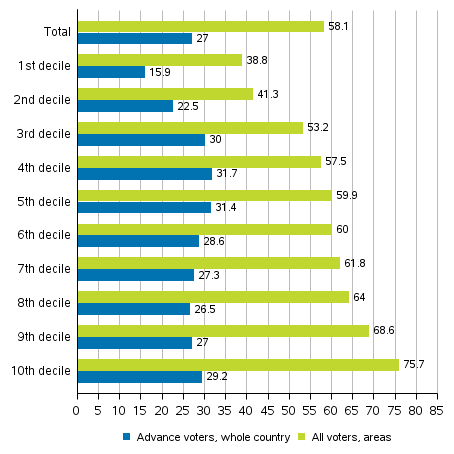
Foreign background
In this review, the background of persons entitled to vote and persons who voted is viewed by means of language and origin. Voting turnout for persons with national languages as their native language was higher than for all persons entitled to vote both among advance voters and all who voted in the areas. In the whole country, 1.1 percentage points more of Finnish and Sami speakers and 0.6 percentage points more of Swedish speakers voted in advance than among all persons entitled to vote. When examining all who voted in the areas, 1.4 percentage points more of Finnish and Sami speakers and 13.4 percentage points more of Swedish speakers voted compared to all persons entitled to vote.
Table 5. Share of those who voted among persons entitled to vote by sex and language in the Municipal elections 2017, %
| Sex | Total | Finnish, Sami | Swedish | Other language | ||||
| Advance voters, whole country |
All who voted, in areas |
Advance voters, whole country |
All who voted, in areas |
Advance voters, whole country |
All who voted, in areas |
Advance voters, whole country |
All who voted, in areas |
|
| Total | 26.6 | 57.5 | 27.7 | 58.9 | 27.2 | 70.9 | 10.3 | 23.9 |
| Men | 24.5 | 55.7 | 25.5 | 57.0 | 24.6 | 69.3 | 10.3 | 22.8 |
| Women | 28.7 | 59.3 | 29.8 | 60.6 | 29.7 | 72.4 | 10.2 | 25.1 |
The voting turnout of foreign-language speakers was clearly lower than for persons with national languages as their native language. Of all foreign-language speakers entitled to vote, 10.3 per cent voted in advance, which was 16.3 percentage points below the level of all persons entitled to vote. Correspondingly, among all who voted in the areas, 23.9 per cent of foreign-language speakers voted, which was 33.6 percentage points fewer than for all persons entitled to vote. (Table 5)
A more detailed examination of the voting turnout of different language groups shows that the highest voting percentage among all votes cast in the areas was found among Swedish speakers (70.9%). Correspondingly, the voting percentage of Finnish and Sami speakers was 58.9 per cent. Figure 6 includes the largest language groups measured by absolute numbers in the areas for which data are available for election day voting. With this limitation, the voting percentage for foreign-language speakers was highest for Somali speakers, 53.0 per cent of persons entitled to vote. Advance voting in the whole country was also exceptionally active in this language group. In the areas, 46.6 per cent of those entitled to vote belonging to the language group voted in advance and 6.4 per cent voted on the election day. For other foreign-language speaking groups, only German speakers’ voting turnout reaches 50 per cent. (Figure 6.)
Figure 6. Share of those who voted among persons entitled to vote by language group in the Municipal elections 2017, %
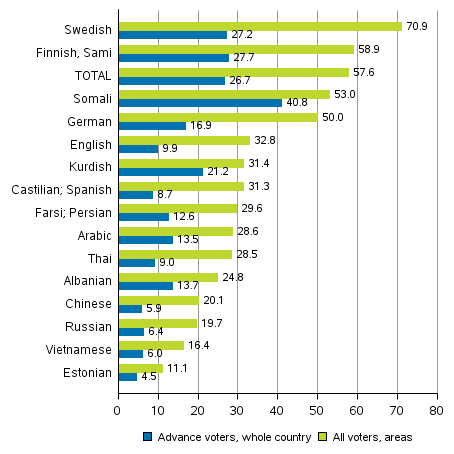
Examined by age group and origin, young people’s voting turnout was lower than in older age groups both among persons of Finnish background and of foreign background. This is visible both among advance voters and all who voted in the areas. Among persons of Finnish background, 27.6 per cent voted in advance and 11.0 per cent of persons with foreign background. Even a bigger difference is seen when examining all who voted in the areas. In the areas, the difference between voting turnout among persons of Finnish and foreign background was 34.5 percentage points. (Table 6)
Table 6. Share of those who voted among persons entitled to vote by origin and age in the Municipal elections 2017, %
| Age group |
Total population |
Persons with Finnish background |
Persons with foreign background |
|||
| Advance voters, whole country |
All who voted, in areas |
Advance voters, whole country |
All who voted, in areas |
Advance voters, whole country |
All who voted, in areas |
|
| Total | 26.7 | 57.6 | 27.6 | 59.4 | 11.0 | 24.9 |
| 18 to 24 | 13.3 | 35.0 | 13.5 | 35.9 | 10.7 | 17.9 |
| 25 to 34 | 15.3 | 43.0 | 16.1 | 45.5 | 8.9 | 19.3 |
| 35 to 44 | 16.7 | 55.3 | 17.5 | 58.5 | 9.4 | 24.6 |
| 45 to 54 | 21.1 | 60.4 | 21.8 | 62.5 | 10.8 | 27.9 |
| 55 to 64 | 32.6 | 67.5 | 33.4 | 68.8 | 12.9 | 30.7 |
| 65 to 74 | 46.3 | 74.6 | 46.7 | 75.1 | 21.4 | 43.1 |
| 75 and older |
41.2 | 60.3 | 41.4 | 60.6 | 24.2 | 40.7 |
Source: Municipal Elections 2017, Review of voting, Statistics Finland
Inquiries: Sami Fredriksson 029 551 2696, Jaana Asikainen 029 551 3506, vaalit@stat.fi
Director in charge: Jari Tarkoma
Updated 5.5.2017
Official Statistics of Finland (OSF):
Municipal elections [e-publication].
ISSN=2323-1114. background analysis of candidates and elected persons 2017,
1. Persons who voted in Municipal elections 2017
. Helsinki: Statistics Finland [referred: 13.12.2025].
Access method: http://stat.fi/til/kvaa/2017/05/kvaa_2017_05_2017-05-05_kat_001_en.html

